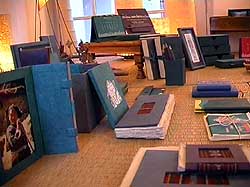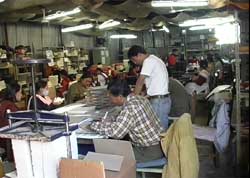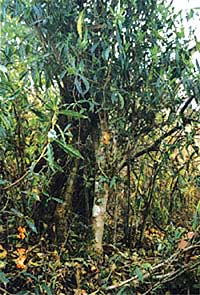 Aglance inside any Nepali government office will prove that the digital revolution has yet to dawn there. All official documents still have to be handwritten on Nepali kagaj.
Aglance inside any Nepali government office will prove that the digital revolution has yet to dawn there. All official documents still have to be handwritten on Nepali kagaj.
Meanwhile, in swish lifestyle boutiques from Nagoya to New York, rainbow hued lokta paper is all the rage-appearing as desk accessories, wallpaper, notebooks, cards, lamps and even clothing.
It's a triumph for an art that had several close shaves with extinction. Lokta paper dates back several centuries, the earliest accounts from the 8th century record that Nepali traders along the northern passes on the Tibet border manufactured and sold it to Buddhist monks to write their scriptures in. But when the trade with Tibet diminished, the craftsmen scattered around the country. In isolated pockets around the Himalaya, they kept alive the art of making paper from the fibrous inner bark of the daphne shrub, locally called lokta. By the 1950s, lokta paper was restricted to a limited supply for government invitation cards, deeds, files and citizenship certificates. The paper made from the pulp of the lokta bark is supposed to be durable and insect-resistant. But when Nepal imported machine-made papers from India, it pushed more papermakers out of business. In 1969 Bibendra Shrestha decided to revive the ancient papermaking tradition and started Nepal Kagaz Udhyog. "I knew that there was no competition for lokta's rare quality," says Shrestha. It took him almost a year to find skilled paper craftsmen who lived in remote areas of Kabhre. With just Rs 24,000 in start-up capital, Shrestha employed 25 papermakers and other 50 lokta collectors in Chalte village. Within a year, he was able to export about a ton of handmade paper to the US and Japan, and managed to find a niche local market among trade houses and government offices.
By the 1950s, lokta paper was restricted to a limited supply for government invitation cards, deeds, files and citizenship certificates. The paper made from the pulp of the lokta bark is supposed to be durable and insect-resistant. But when Nepal imported machine-made papers from India, it pushed more papermakers out of business. In 1969 Bibendra Shrestha decided to revive the ancient papermaking tradition and started Nepal Kagaz Udhyog. "I knew that there was no competition for lokta's rare quality," says Shrestha. It took him almost a year to find skilled paper craftsmen who lived in remote areas of Kabhre. With just Rs 24,000 in start-up capital, Shrestha employed 25 papermakers and other 50 lokta collectors in Chalte village. Within a year, he was able to export about a ton of handmade paper to the US and Japan, and managed to find a niche local market among trade houses and government offices.
Things took a bad turn when, a few years later, he was diagnosed with cardiac problems and his paper plant was completely destroyed in a storm. "Even after I lost all I had, I kept on going since this was the most sustainable income generation activity for a lot of people," says Shrestha, who now runs a mini paper factory at his own residence in Kuleswor. He has earned a reputation for being one of the best designers for handmade paper projects like lokta jackets, bags, shoes and wallpaper.
 Almost around the same time, Bishnu Shrestha had just returned from London with a degree in printing technology. Instead of rejoining Gorkhapatra, he started working with Unicef to revamp Bhaktapur Craft Printers (BCP), a partially government owned company. This not only helped to revitalise papermaking but also promoted another traditional Nepali art-block printing. The combination of the two produced high quality lokta paper products for the international market.
Almost around the same time, Bishnu Shrestha had just returned from London with a degree in printing technology. Instead of rejoining Gorkhapatra, he started working with Unicef to revamp Bhaktapur Craft Printers (BCP), a partially government owned company. This not only helped to revitalise papermaking but also promoted another traditional Nepali art-block printing. The combination of the two produced high quality lokta paper products for the international market.
Unicef guaranteed BCP a permanent market through its Geneva-based international greeting cards operation. With help from Japan, which has its own tradition of handmade paper, JICA sponsored the training of Nepali entrepreneurs in the Japanese technology of using recycled lokta paper trimmings and scraps.
For a visionary and ambitious entrepreneur like Bishnu Shrestha, working in an NGO was stifling. So, in 1991 he started his own Nepal Paper Products, and today his company is a top Nepali paper exporter with a total revenue of Rs 27 million. Inspired by his success, more entrepreneurs invested in the lokta business. In the last few years about 170 companies have opened up around the country, providing employment to more than 20,000 people with 80 percent of them women. This also helped establish thousands of outlets around the country to display lokta products, spinning off extra income from retail outlets that cater to tourists.
With even more companies entering the sector, there is little danger of the bottom falling out of the business as it did with carpets and pashmina. To prevent cut-throat competition and a subsequent loss of quality, lokta paper entrepreneurs follow a code of strict business ethics and conduct. The establishment of Nepal Hand Paper Association (HANDPASS) has helped to build an atmosphere of fraternity and mutual understanding. Companies do not steal or compete for international clients. Top priority is given to rural communities who are guaranteed that paper products will be manufactured in their own villages. Only finishing and polishing up the end product is done in the city.  Villages in remote Baglung, Sindhupalchok, Myagdi, Parbat, Sankhuwasabha, Ilam, Taplejung, Ramechhap, Kabhre, Jajarkot, Dolkha and others are reaping benefits from lokta paper. Rabi Lama is a local hero in his remote village near Panauti. After working for 15 years in a factory in Kathmandu, he returned and started his own small manufacturing unit. He works shoulder to shoulder with his employees, all 25 of them recruited from the village. "Now they don't have to go to India or elsewhere to work," says Lama.
Villages in remote Baglung, Sindhupalchok, Myagdi, Parbat, Sankhuwasabha, Ilam, Taplejung, Ramechhap, Kabhre, Jajarkot, Dolkha and others are reaping benefits from lokta paper. Rabi Lama is a local hero in his remote village near Panauti. After working for 15 years in a factory in Kathmandu, he returned and started his own small manufacturing unit. He works shoulder to shoulder with his employees, all 25 of them recruited from the village. "Now they don't have to go to India or elsewhere to work," says Lama.
Most companies discourage child labour, provide fair employment practices, clean working conditions and offer health and education benefits. "What also makes them unique is the socially responsible behaviour of many companies," says Stephen Biggs, a visiting scientist at ICIMOD. These basic practices are also an advantage for the company who is able to truthfully represent themselves in the exacting international market as socially and environmentally proactive .
Today, handmade craft paper produced solely through indigenous technology ranks as one of Nepal's top handicraft exports. After the paper found its way into the international market in Europe and the US during the early 1990s, business has boomed. While other handicrafts like pashmina and jewellery nosedived, handmade paper sales grew by over 300 percent. Annual earnings catapulted from just Rs 67 million in 1997 to Rs 275 million in 2002.
No worries
 With everyone jumping on the lokta paper bandwagon, some are worried about loss in quality and even that the plant will be unsustainably harvested. They are also afraid that small companies will flood the market with cheap products at low prices. "Exports might go down if this trend continues," says Dinesh Shrestha of Bagmati Paper Industry, an exporter. He adds that raw materials are smuggled across the open border to India and products are already being sold at very cheap prices.
With everyone jumping on the lokta paper bandwagon, some are worried about loss in quality and even that the plant will be unsustainably harvested. They are also afraid that small companies will flood the market with cheap products at low prices. "Exports might go down if this trend continues," says Dinesh Shrestha of Bagmati Paper Industry, an exporter. He adds that raw materials are smuggled across the open border to India and products are already being sold at very cheap prices.
Others think that worries about lokta going the way of pashmina are overblown. "There is already a good market for high quality products and price will not matter," says Stephen Biggs at ICIMOD. Lokta entrepreneurs have a strong network and make a collective endeavor to improve the industry. Although thousands of collectors in rural areas are involved in harvesting. There is no need to worry about the plant dying out, experts say. The plant is conserved and managed well by community forest users groups. "In fact there is under-harvesting, not even 20 percent of the plants have been harvested," says Nepal Paper Products' Bishnu Shrestha.



